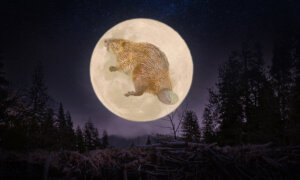Mulberry Moon. Budding Moon. Milk Moon.
The names traditionally given to May’s full moon abound—but the most famous of all probably belongs to the Flower Moon.
Before we had digital calendars on our smartphones, the moon was for thousands of years used by myriad civilizations to track time and divvy up the year. Our calendar of today is based on that lunar lineage.
Also inherited were the colorful names given to each month’s full moon—denoting not just its precise moment of fullness but the entire calendrical month. Those names weren’t drawn out of a hat; the minds of our forefathers were focused on the signs of the seasons.
So, it’s simple to understand why our ancestors gave the Flower Moon its florid name: spring!

A full moon over spring flower blossoms. (Onkamon/Shutterstock)
Look out your window, and you will probably see budding green or blooming flowers right about this time. Surely our ancestors saw similar scenes.
The Full Flower Moon this year will fall at exactly 9:53 a.m. EDT on May 23, though it will happen below the horizon and out of sight for hopeful viewers in North America. But worry not. On both the nights of May 22 and May 23, it will appear full to the human eye.
Bright Moon. Hare Moon. Mother’s Moon.
There are plenty more moon names where those came from. Many that we are familiar with stem from Colonial and Native American and European heritage. They have history and folklore in spades.
But the Flower Moon in particular was so named by the Algonquin peoples, according to Almanac, who confirmed this with Christina Ruddy of The Algonquin Way Cultural Centre in Pikwakanagan, Ontario.
Famed Colonial explorer Jonathan Carver denoted May’s moon as “Month of Flowers” in his “Travels Through the Interior Parts of North America: 1766, 1767, 1768,” published in 1798, after staying with the Naudowessie (Dakota) people in the Great Lakes region for a period.
The historic writings of Henry David Thoreau also mention both the Flower Moon and Carver, attesting to these origin stories.

Full moons have traditionally been named based on observations of the seasons. (bphuyal/Shutterstock)
According to the Farmer’s Almanac, names like “Mulberry Moon” and “Camas Blooming Time,” used by North American Natives, referenced the time of blossoming for those respective trees and flowers.
“Milk Moon” dates to Medieval Europe, when farmers brought cows out to pasture in May, providing them rich nourishment to nurse newborn calves. “Hare Moon,” “Bright Moon,” “Mother’s Moon,” and “Grass Moon,” of Old English and Celtic heritages, are among the many other moon names.
So, as we usher out the cold and breathe in the sweet scent of spring flowers, we may reflect—in the light of the Flower Moon perhaps—on the consciousnesses of our fathers, mothers, sisters, and brothers before us, who probably were contemplating the same seasonal signs as us.
Share your stories with us at emg.inspired@epochtimes.nyc, and continue to get your daily dose of inspiration by signing up for the Inspired newsletter at TheEpochTimes.com/newsletter









